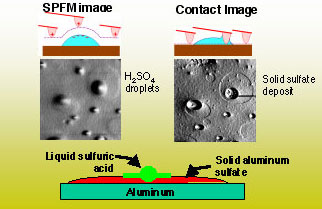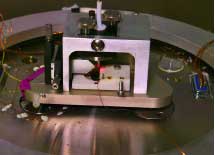Non-contact Nanoscale Imaging of Liquids and Weakly Bound Material
APPLICATIONS OF TECHNOLOGY:Detection of contamination in semiconductor processing Detection of liquid films affecting wetting and adhesion on surfaces Imaging of liquids interacting with organic material in biological systems Characterization of biomaterials:
o Hydrophilic and hydrophobic regions o Areas of different ionic concentration
ADVANTAGES:
First microscope to enable nanoscale imaging of very weakly bound materials on solid or liquid surfaces Minimizes interaction between the microscope and sample surface Works with samples of any thickness Has a laterial resolution of ~ 50 nm and a vertical resolution of ~ 0.1 nm
ABSTRACT:
Miquel Salmeron and colleagues at Berkeley Lab have modified non-contact atomic force microscopy to develop a scanning polarization force microscope (SPFM) that can be used to image liquids and very weakly bound materials at nanometer scales.
The novel feature of this patented instrument is that it minimizes the interaction between the microscope tip and the sample surface. Now ultra-small particles such as dust and contamination, nanometer liquid films, and nanosize liquid droplets can be imaged at scales never before achieved. Electron microscopes destroy these types of samples and are also unable to image insulating substrates. Conventional atomic force microscopes brush away or wick liquid or weakly bound samples. Optical microscopes lack the resolution for nanoscale imaging.
Berkeley Lab’s scanning polarization force microscope measures and maps the electric field from the electrostatic charges in materials as well as induced molecular and atomic polarization fields. This invention is useful for imaging dielectric and insulator substrates and metal surfaces, including contamination in semiconductor processing. It will also find application in the study of biomaterials and biological systems.
Attached files:


Inventor(s): Miquel Salmeron
Type of Offer: Licensing
« More Nanotech Patents
